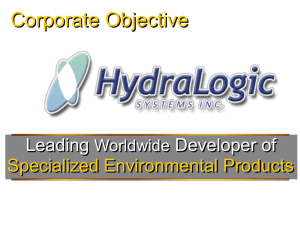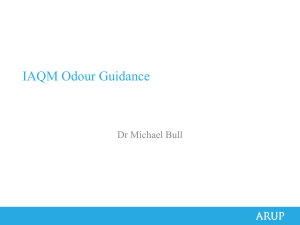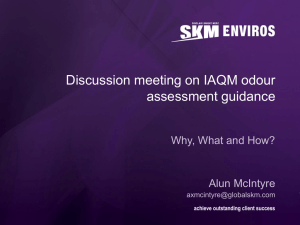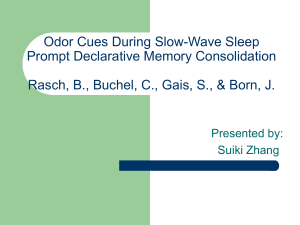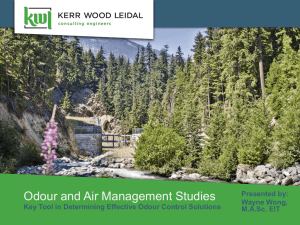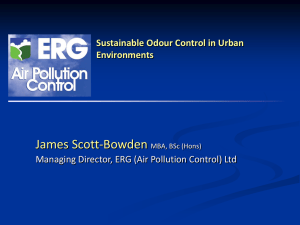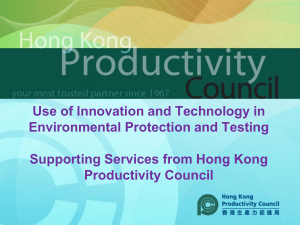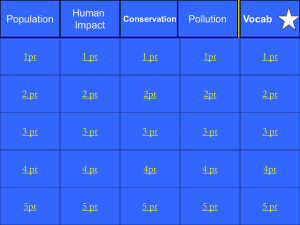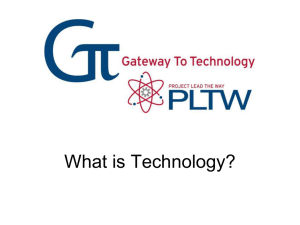NIEA enforcement policy - Department of the Environment
advertisement
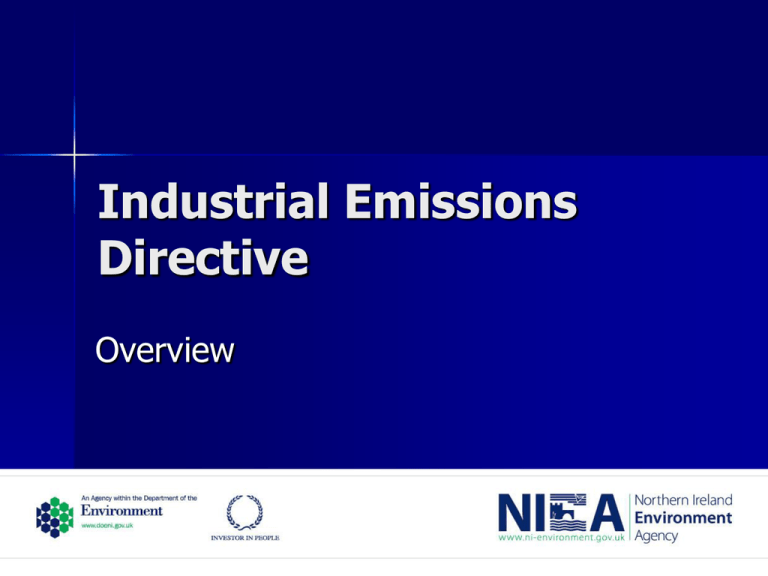
Industrial Emissions Directive Overview Purpose Update IPPC Directive Combine sectoral directives into a single text [Large combustion plant, waste incineration, VOC, titanium dioxide etc] Key dates Publication OJ 17 December 2010 Transposition required by January 2013 [applies to new activities from that date] Applies to permitted activities at existing installations from January 2014 Applies to newly prescribed activities at existing installations from July 2015 Applies to existing large combustion plant from January 2016 What’s new (1) Articles 7 and 8: Requirement for operator to report incidents/accidents or permit breaches, take measures to limit consequences and take any additional measures required by competent authority Article 8: Requirement to suspend operation if immediate danger to health or threatens significant adverse environmental impact. What’s new (2) Article 12 (and 22): requirement for baseline report with application where there is a risk of contamination of soil or groundwater with hazardous substances. Affects existing installations at first permit update after Jan 2014. What’s new (3) Article 15: permits to reflect elvs in BAT conclusions – any departure requires justification [Article 15(4)]. Article 16: monitoring requirements also based on BAT conclusions. Minimum 5yr freq for groundwater and 10yr for soil unless systematic appraisal of risk. What’s new (4) Article 21: permits to be updated to reflect BAT conclusions (and installation compliant) within 4 years of publication. Article 23: inspection requirements based on RMCEI: little change in practice. What’s new (5) Article 24: Permits, decision documents, permit updates, reasons for Article 15(4) derogations, measures taken on definitive cessation of operations all placed on internet. Changes to prescribed activities (Relevant to food sector) Waste management: recovery of non hazardous waste included if capacity>75 tes per day ( >100 tes per day if AD only), changes to incineration activity descriptions. Food production from vegetable raw materials >300 tonnes per day. Now capacity based rather than ‘average value on a quarterly basis’ Mixed animal / vegetable raw materials: formula included. No change to animal raw materials, milk or rendering. Implementation in NI Pollution Prevention and Control (Industrial Emissions) Regulations 2012 made 14/12/12 Pollution Prevention and Control (Industrial Emissions - NIEA) Charging Scheme made 7/1/13 Implications for existing operators New Regs will apply alongside current Regs until January 2014. New Regs contain deemed conditions to cover Article 7 and Article 8 of the Directive. Reporting incidents/accidents/permit breaches. Requirement to suspend operations if immediate danger to health or immediate risk of significant adverse environmental impact. May need permit amendment to reflect Article 16 NIEA enforcement policy Overview of policy and arrangements for implementation Policy overview - - Revised policy published in January 2011 after extensive consultation. Principles: Proportionate Consistent Transparent Targeted Enforcement tools Warning letters Notices (works, prohibition, suspension, enforcement) Review, variation and revocation Financial penalties (eg EUETS, marine licences) Injunction Prosecution Confiscation (proceeds of crime) Paragraph 26 – [presumption to prosecute if sufficient evidence] Incidents which have significant consequences or potential consequences for the environment. Operating without relevant licence. Failure to comply with formal remedial requirements. Excessive or persistent breaches. Failure to report an incident. Reckless disregard for management or quality standards. Failure to supply information when legally required. Obstruction of NIEA officers. Failure to comply with a fixed penalty notice. Short term response. For an incident, priority is corrective action to remove risk: immediate response may be a notice. More detailed investigation is likely to follow where one or more of the paragraph 26 criteria applies Case reviews (1) Each case where a notice or more serious action is deemed necessary is assessed using a case review template. Interim review will determine whether to undertake a formal investigation. Final review will determine whether to submit a file to the PPS. Case reviews (2) Case review includes line manager. A sample of cases is selected for review by an Environmental Protection Directorate team to promote consistency. Process subject to audit by Govt internal audit and Criminal Justice Inspectorate Impact of prosecution Resource intensive for agency. Reputational damage for defendant. Strong incentive to improve compliance and reduce incidents for all involved. Role of sector based working and case studies. Rendering Sector Key Technical Issues Main Issues Odour Effluent Treatment Plants Noise Permit Review Odour (1) - - SG8 and SNIFFER Report Environment Agency H4 Odour Management Guidance - March 2011 Permit conditions (a) compliance with odour management plan (b) no pollution beyond the site boundary; use of BAT Odour management plan should identify potential sources of odour and be designed to: Employ appropriate methods, including monitoring and contingencies, to control & minimise odour pollution Prevent unacceptable odour at all times Reduce the risk of odour releasing incidents or accidents by anticipating them and planning accordingly Odour (2) Three levels of odour Benchmark Level Unreasonable odour amounting to serious pollution is being or is likely to be caused (regardless of whether appropriate measures are being used). Must take further action or you may have to reduce or cease operations – Agency would not issue a permit if considered to be operating at this level. Odour pollution is or is likely to be caused beyond boundary. Operator’s duty is to use appropriate measures to minimise odour. If appropriate measures are being used, residual odour will have to be tolerated by the community. No odour beyond the boundary or likely to be = no pollution = no action necessary Odour (3) • In any particular case NIEA has to decide: (1) Is there serious pollution? Conclusion best based on a number of assessment techniques (a) Subjective assessment FIDOR – Frequency; Intensity; Duration; Offensiveness; Receptor sensitivity (factors which determine degree of odour pollution) – (NIEA Odour Impact Assessment Guidance) (b) Air dispersion modelling/Measurement 1 Odour unit, OU/m3 = point of detection (when ½ population should detect odour) Odour benchmark levels (modelled 98th percentile hourly average): 1.5 most offensive eg. rendering – (but <1 if neighbour sensitised) 3.0 moderately offensive eg. int agric, feed mills 6.0 less offensive odours eg. bakery Results above benchmark level indicates the likelihood of unacceptable odour pollution and enforcement action Odour (4) (2) Is the operator taking appropriate measures? BREFS; H4 odour guidance; industry guidance and best practice (SNIFFER report) When determining what appropriate measures will be for a site NIEA will factor in needs, costs & benefits. In practice this means the higher level of pollution the more measures you will be expected to take and the greater the justifiable financial investment will be. NIEA will work closely with operators to help them find mutually acceptable solutions Odour (5) ABPs/rendering are likely to be the major odour sources but ETPs can also cause odour problems Prevent build up of Fats and Solids Keep effluent fresh and moving Provide sufficient aeration in the appropriate tanks Effectively manage sludges Maintain an odour management plan, and record changes in odour from the plant daily – Often a sign of changes in plant / spillages / breakdown of equip. BAT – – Cover buffer and sludge tanks and vent through abatement system Enclose DAFs/sludge handling plant and vent through abatement system Good preventative maintenance programme Engage neighbours & respond to complaints Keep complainants informed of any problems and what actions are being taken to resolve issues Odour (6) Odour complaints about rendering - vast majority of IPRI complaints NIEA – risk of investigation by Ombudsman (failure to ensure adequate control measures are implemented to prevent pollution) Operator – risk of civil action by local residents (for failure to prevent odour nuisance) Example cases in England Effluent Treatment Plants The sector produces large effluent volumes with high Ammonia, BOD and SS in effluent and some plants discharge directly to a water course, however most discharge to sewer. The primary goals of the ETP are: Removal of organic matter (BOD), removal of Suspended Solids, Ammoniacal Nitrogen and Total Phosphorus. Effluent Treatment Plants Objective: Protecting receiving water quality Solids “suffocate” benthic organisms and may increase turbidity and decrease light penetration BOD/COD – oxygen depletion in water and harms the environment i.e. Fish kills, Septicity, Odours Ammonia Nitrogen – Toxicity, pH changes, Eutrophication Phosphate - Eutrophication, Drink Water Standards Effluent Treatment Plants Critical Monitoring required on site: Influent: Daily Composite sample tested for Ammonia, COD/BOD, SS, Phosphorus, and Fat. Continuous Flow & pH Post solids removal, balancing tank & DAF plant: COD/BOD, SS, Ammonia and continuous pH. Effluent Treatment Plants Monitoring of Activated sludge plants : Daily Nitrate(NO3) Ammoniacal Nitrogen (NH3-N) MLSS test Food to Mass (F/M) ratio calculation Cone settlement test (SVI) Continuous monitoring of DO (Ideally linked to aerators / blowers) Microscopic examination of sludge. Additional useful information: Ammonia (NH4) Nitrite (NO2), Alkalinity, Phosphorous ETP Operation Discharge Monitoring required: Daily composite COD/BOD, SS, and pH - Sewer Ammoniacal Nitogen, Total Phosphorus - Water Continuous monitoring of Flow, pH & Temp Continuous SS and Turbidity meters are useful, but not mandatory. Record Keeping is vital – Management sign off. Routine Maintenance and Calibration Monitoring equipment and data loggers. PPM or Maintenance contract required. Noise (1) Specific issues/ possible solutions Many significant noise sources e.g. vehicles, fans, pumps, compressors, condensers, boilers/TO, generators, aerators, steam vents, etc. Faulty plant – giving rise to whines, screeches, high pitch/tonal noise: use adequate preventative maintenance Alarms going on for long periods of time – wire alarms to staff mobiles/turn off automatically after a short period of time Fans/ancillary equipment – use timers, turn fans off at night if not required Silencers for steam vents/Acoustic Enclosures/Louvres Noise (2) Unacceptable noise impact = Pollution A noise management plan usually needed – – – – – noise sources/drawing, noise control measures, noise monitoring (subjective/objective), noise sensitive receptors/drawing, and contingency plans for incidents, complaints, etc. Ensure that noise control measures are checked and maintained Noise (3) Carry out appropriate level of noise monitoring (subjective/objective) Subjective at NSR - none, listen for, easily identified, obvious* Rating LAr< 55 dBA day or < 45 dBA & LAmax<60 dBA outside bedroom window - WHO Background LA90 – excludes noise generated by the site – Section 7.3/4** Complaints likely if rating >5-10 dB above background - Section 9** [* see H3 guidance and ** see BS4142] Permit Review - Updated/simpler/consistent permit conditions New generic conditions added e.g. F-Gases/PFO ELVs for discharges to surface water standardised where possible – Weekly sampling and analysis Annual reporting as standard NIEA hope to issue “DRAFT” variation notices by June 2013 for operator comment/feedback Likely spector odour control conditions/improvements: Back up systems for TO trips Raw material doors interlocked with raw material feed bins Annual olfactometry monitoring, but no ELV for odour Annual building intregrity testing Review/update of Odour Management Plan Rendering Sector Compliance Issues and Learning Thermal Oxidiser Trips Thermal Oxidiser trips recorded on all NI plants, but frequency varies. Example reasons: – Electrical faults; – Water pressure / level faults; – Burner faults Unabated / less abated releases following trips can cause significant off site odour. T.O. Trips: Learning Points Analyse causes of trips and implement corrective action. Ensure preventative maintenance programmes reflect the manufacturer’s recommendations and your operating experience. Process changes : Impact on Effluent Treatment Plants Process change led to transfer of high BOD, high ammonia effluent at increased volume which ETP was incapable of treating. Extended non compliance, high costs for effluent transfer, enforcement action. ETP overloading: Learning Points ETP capacity needs to be designed to match actual or changed duty. Management of Change – evaluate consequences of process changes on ETP as part of decision making / approval process. Failure to assess these aspects can lead to significant environmental and business risk. Contingency plans for ETP failure. Raw Material Management Storage and handling of raw material: – Vehicle management / external operations; – Spillages during unloading; – Internal housekeeping; – Management of material in the event of a breakdown. Raw material: Learning Points Ensure employees are aware of permit requirements and procedures for handling and storage of material. Procedures for assessing quality of material and appropriate response: rejection or other sanctions Prompt cleaning of internal and external spillages. Diversion plans are in place in the event of a breakdown or other unplanned event. Common issues for food and drink sector ETPs – design, monitoring, control, training. Management of process change Control of contractors Contamination of ‘clean’ yard areas Drain blockage NIEA Waste Management Licensing What is Duty of Care? Duty of Care is a law (Controlled Waste (Duty of Care) Regulations (NI) 2002) that says you must take all reasonable steps to keep your waste safe. If you give your waste to someone else you must ensure they are authorised to handle it and can transport, recycle or dispose of it safely. Duty of Care applies to anyone who imports, produces, carries, keeps, treats or disposes of controlled waste including those who broker waste. Failure to comply could result in prosecution. The Waste Regulations (NI) 2011 The Waste hierarchy Stronger enforcement Requirement for dealers and exempt persons to register as waste carriers Upper Tier Registered Carriers are most operators which carry controlled waste – £132 for 3yrs – Renewal £67 (correct as of Feb 2013) Lower Tier Carriers (no fee) are typically; a waste collection authority (local council), Charity, voluntary organisation, or those who carry, broker or deal in animal by products. What’s the Department doing? Revised Code of Practice published Revised Waste Transfer Note – NB Waste Hierarchy Duty of Care & Registration of Carriers Leaflet published – Newsletters, Twitter, etc. Further Consultation Paper – reclassification of waste, SIC Code 2007, WTN with vehicle, destination. Anaerobic Digestion Sending rendered 02 01 02 and 02 02 02 Cat 2 ABP to an anaerobic digestion plant Developing your own Anaerobic Digestion Facility Anaerobic Digestion Regulation of Anaerobic Digestion http://www.doeni.gov.uk/niea/regulation_of_ad_waste.pdf Commissioning An Anaerobic Digestion Plant http://www.doeni.gov.uk/niea/ad_commissioning.pdf Operating An Anaerobic Digestion Plant http://www.doeni.gov.uk/niea/ad_operational_procedures.pdf Anaerobic Digestate Anaerobic Digestate Quality Protocol http://www.environmentagency.gov.uk/static/documents/B usiness/AD_Quality_Protocol_GEH O0610BSVD-E-E.pdf Better Regulation Better Business Better Environment Carol Majury Better Regulation Team 12 March 2013 Policy Drivers 2005 Hampton Report - Inspection and Enforcement 2006 Macrory Review – Sanctions 2006 Davidson Review - Legislation 2008 Anderson Review - Guidance on Regulation 2011 Penfold Review - Non-planning consents Northern Ireland Better Regulation Strategy (2001) Northern Ireland Response • Better Regulation for a Better Environment (2008) • Agri-food Better Regulation and Simplification Review (2009) • Environmental Better Regulation White Paper (2011) New Chief Executive Terry A’Hearn (Nov 2012) New Strategic Objective (9 May 2013) “To create prosperity and well-being through environment and heritage excellence.” Environmental Better Regulation White Paper Integrated Permitting Unified Inspection & Investigatory Powers Better Regulation Bill during 2014 Environmental Offences (administrative and criminal sanctions) 57 Environmental Offences Bill Consultation Paper on proposals for an Environmental Better Regulation Bill AIMS: • reduce 21st Century Regulatory the Innovation administrative and compliance burden on legitimate businesses, • reduce the regulatory costs borne by the Department and • enhance the protection of the environment. Integrated Permitting Tiers of Control • General Binding Rules – small risk • Registration – cumulative impacts • Standard Permits – sector based • Bespoke Permits – complex and high risk Unified Inspection and Investigatory Powers Currently: – over 200 pieces of environmental legislation – about 50 with powers of inspection and investigation. Aim: To consolidate and define investigatory powers for officers carrying out inspections. Risk Based Inspections Enforcement Currently: Penalties applied through criminal justice system with monetary fines and, in extreme cases, custodial sentences. Aim: To see a more consistent, flexible and proportionate environmental penalties and sanctions regime. Penalties and Sanctions • Compliance notice to secure that an offence does not continue or recur. • Restoration notice to restore harm caused by an offence. • Stop notice prohibiting a person from carrying out an activity which is, or is likely, to present a significant risk of serious harm to human health or the environment. • Enforcement Undertaking sets out how the alleged offence does not continue or recur; what actions will be taken to ensure that restoration will be secured; or what equivalent benefit or improvement to the environment is being offered. Consultation Environmental Better Regulation Bill 21st Century Regulatory Innovation Propose to issue the Consultation Document in June 2013 Waste Quality Protocols 65 Anaerobic Digestate Protocol Under revision •Definition of animal by-products •Acceptable animal by-products •EWC code 02 02 04: Wastes from preparation and processing of meat ……including blood……. ‘Sludges from on-site effluent treatment’. 66 New EU Life+ Projects Ensuring Quality of waste derived products to achieve resource efficiency 67 New EU Life+ Projects Electronic Duty of Care Project 25 million waste transfer notes in UK each year and 50 million paper documents being stored at any time 68 NetRegs.org.uk
